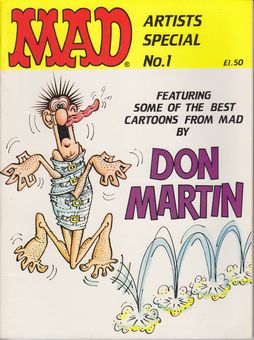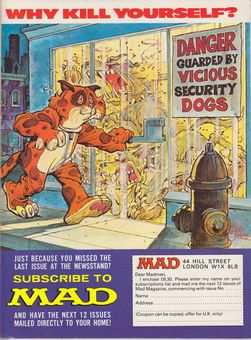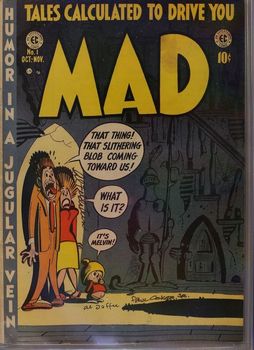Mad artists special no 1
| série: | Mad Magazine |
| dessinateur / scénariste: | Don Martin |
| éditeur: | Mad USA |
| genre: | Satirisme |
| classement: | carton131 |
| date: | 1970 |
| format: | broché |
| état: | TBE |
| valeur: | 10 € |
| critère: | ** |
| remarques: | Mad is an American humor magazine founded in 1952 by editor Harvey Kurtzman and publisher William Gaines, launched as a comic book before it became a magazine, it was widely imitated and influential, affecting satirical media, as well as the cultural landscape of the 20th century, with editor Al Feldstein increasing readership to more than two million during its 1974 circulation peak editors: Harvey Kurtzman (1952–56) and Al Feldstein (1956–84) the magazine is the last surviving title from the EC Comics line, offering satire on all aspects of life and popular culture, politics, entertainment and public figures this magazine titled artists special No. 1 (1970) is a UK publication, black and white, 60 pages featuring some of the best cartoons from Mad by Don Martin Information A) Don Martin Don Martin (May 18, 1931 – January 6, 2000) was an American cartoonist whose best-known work was published in Mad from 1956 to 1988, his popularity and prominence were such that the magazine promoted Martin as "Mad's Maddest Artist" born on May 18, 1931 in Paterson, New Jersey, and raised in nearby Brookside and Morristown, Martin studied illustration and fine art at Newark School of Fine and Industrial Arts between 1949 and 1951 and subsequently graduated from the Pennsylvania Academy of the Fine Arts in Philadelphia in 1952, in 1953, he worked briefly as a window trimmer and frame maker before providing paste ups and mechanicals for various offset printing clients and beginning his career as freelance cartoonist and illustrator Martin's work first appeared in Mad in the September 1956 issue, Martin brought his portfolio to the Mad offices in 1956 and was immediately given an assignment Martin often was billed as "Mad's Maddest Artist" whereas other features in Mad, recurring or otherwise, typically were headed with pun-filled "department" titles, Martin's work always was headed with only his name: Don Martin Dept, further fanfare presumably being unnecessary at his peak, each issue of Mad typically carried three Martin strips of one or two pages each, but Martin also did several longer pieces, including parodies of poems by writers like Longfellow, Coleridge and Clement Clarke Moore, thematic collections of gags on a single subject such as Moses, superheroes or Dracula as well as full parodies of the Gentle Ben TV series and the film Excalibur, he also drew some insert bonus material for "Mad Specials" such as stickers and posters although Martin's contributions invariably featured outrageous events and sometimes outright violations of the laws of space-time, his strips typically had unassuming generic titles such as "a quiet day in the park" or "one afternoon at the beach." the six-panel "the Impressionist" features a bull who becomes a famous artist by smearing an outdoor painter against his canvas and displaying his remains as an abstract design, the four-panel "one night in the Miami Bus Terminal" presents a man who approaches a machine labeled "Change," inserts a dollar bill and changes to a woman in another gag, a man is flattened by a steamroller but is saved by the intervention of two passersby who fold him as a paper airplane and throw him to the nearest hospital B) Mad magazine Mad began as a comic book published by EC, debuting in August 1952 (cover date October–November), and located in lower Manhattan at 225 Lafayette Street, in the early 1960s, the Mad office moved to 485 Madison Avenue the title is trademarked in capitals as MAD, the first issue was written almost entirely by Harvey Kurtzman and featured illustrations by Kurtzman, along with Wally Wood, Will Elder, Jack Davis and John Severin, Wood, Elder, and Davis were the three main illustrators throughout the 23-issue run of the comic book to retain Kurtzman as its editor, the comic book converted to magazine format as of issue #24 (1955), the switchover only induced Kurtzman to remain for one more year, but crucially, the move had removed Mad from the structures of the Comics Code Authority, after Kurtzman's departure in 1956, new editor Al Feldstein swiftly brought aboard contributors such as Don Martin, Frank Jacobs, and Mort Drucker and later Antonio Prohías, Dave Berg, and Sergio Aragonés, the magazine's circulation more than quadrupled during Feldstein's tenure, peaking at 2,132,655 in 1974; it later declined to a third of this figure by the end of his time as editor, when Feldstein retired in 1984, he was replaced by the team of Nick Meglin and John Ficarra who co-edited Mad for the next two decades, since Meglin's retirement in 2004, Ficarra has continued to edit the magazine Gaines sold his company in the early 1960s to the Kinney Parking Company which also acquired National Periodicals (a.k.a. DC Comics) and Warner Bros. by the end of that decade, Gaines was named a Kinney board member and was largely permitted to run Mad as he saw fit without corporate interference following Gaines' death, Mad became more ingrained within the Time Warner corporate structure, eventually, the magazine was obliged to abandon its long-time home at 485 Madison Avenue and in the mid-1990s it moved into DC Comics' offices at the same time that DC relocated to 1700 Broadway, in 2001, the magazine broke its long-standing taboo and began running paid advertising, the outside revenue allowed the introduction of color printing and improved paper stock. though there are antecedents to Mad's style of humor in print, radio and film, Mad became a pioneering example of it, throughout the 1950s, Mad featured groundbreaking parodies combining a sentimental fondness for the familiar staples of American culture, such as Archie and Superman, with a keen joy in exposing the fakery behind the image |
| couvertures: |    |
Copyright 2008 - 2025 G. Rudolf
